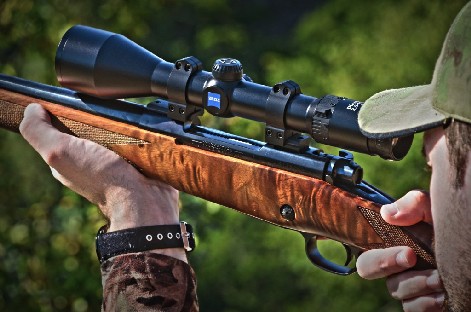 Having mounted a number of magnified and non-magnified optics on long guns and handguns in my brief time as a firearms operator, I have a few thoughts on optic mounting rings.
Having mounted a number of magnified and non-magnified optics on long guns and handguns in my brief time as a firearms operator, I have a few thoughts on optic mounting rings.
Like many who are handgun enthusiasts, I have a holster drawer or two. I would venture to say that, like long gun enthusiasts, I also have an optic ring and optic mounting base drawer. I, like some, may also have a “scope drawer” with several magnified and non-magnified optics that just haven’t made the cut or that are just waiting for the right firearm to which they will be mounted.
While not claiming to be any kind of expert on scope rings and mounts, I thought that I would share some thoughts while seeking some sort of solace as to why I have scope rings carefully packaged, protected, and cataloged so as not to be characterized as being a “scope ring hoarder.”
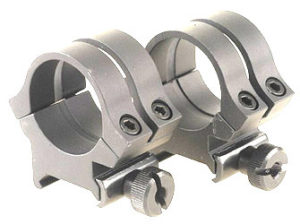
Weaver Quad Rings
The decision to purchase a certain magnified or noon-magnified optic, optic rings, and/or optic mount is totally subjective on the firearm operator’s part and in no way am I going to recommend a certain magnified or non-magnified optic, optic rings, and/or optic mount. But, I will attempt to take you through my journey with optic rings as best as I can articulate.
At some point in time, I decided that I could mount a magnified or non-magnified optic and bypass the expense and expertise of a qualified gun smith to do so. I quickly learned why I had paid the expense for a qualified gun smith. Mounting a magnified or non-magnified optic takes patience and the correct tools for the job. Luckily, I have the patience and proper tools were soon in hand. Lest I digress further, let’s get to the optic ring part.
Some optics can be purchased with rings to mount the optic. This is very handy in most cases, because the rings are most likely matched (somewhat) to the optic. However, there may be cases where the rings are not what are needed for the particular application of the firearm or its physical characteristics. For example, you purchased a magnified optic, which included mounting rings, for a rifle equipped with front and rear sights. Unfortunately, with the provided rings, the scope will not clear the rear sight, which means that you go shopping for mounting rings that will allow the magnified optic to clear the rear sight – or you simply remove the rear sight – or possibly change the height of the base.
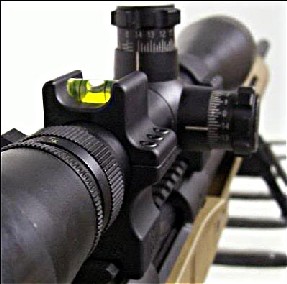
Bubble Level Scope Rings
A good “scopes man” will usually have on hand three heights of relatively cheap optic rings to help determine the correct optic mounting height. Once the desired optic mounting height is achieved, the desired optic mounting rings can be determined.
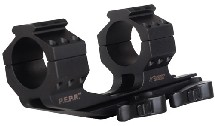
Burris Integral QD Scope Mount
There are also two different methods of securing the optic to the rings; side and top. Even with these two choices, there are several different optic securing options; one-point, two-point, four-point, and even six-point.
Optic rings may also be integrated with a base that attaches directly to the rifle’s receiver. One that comes to mind is a Weigand unit for the Ruger 10/22. Leupold also has offerings in integral base/ring combinations for various rifles.
Optic rings can also be found in steel and aluminum. Steel rings will be heavier and more prone to corrosion than aluminum (that means between the rings and the optic and not just on exterior surfaces). Aluminum rings are obviously much lighter than steel, but the soft material may also be prone to the threads stripping due to over-tightening mounting screws.
Recoil is a major consideration for some when selecting optic rings and bases. In order for a magnified or non-magnified optic to be effective, it must be able to withstand the effects of recoil. While most all optic mounting rigs will work with a very low recoiling firearm, an excessive recoiling firearm can affect both the optic and optic mounting system if the system is not wisely chosen. When attempting to qualify optic mounting rings into groups of recoil sensitivity, very little if any information can be found. One would assume that a six-point optic securing system would be over-kill on a .22 caliber rifle, what optic mounting ring system is needed to secure and protect the optic on an extremely high recoiling rifle? Conventional wisdom dictates to use the lightest optic ring system due to weight concerns, but that wisdom may not be correct thinking.
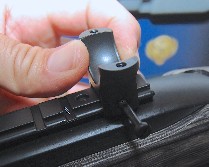
Burris Signature Scope Ring
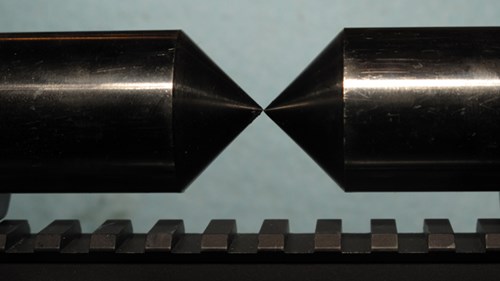
Scope Ring Alignment
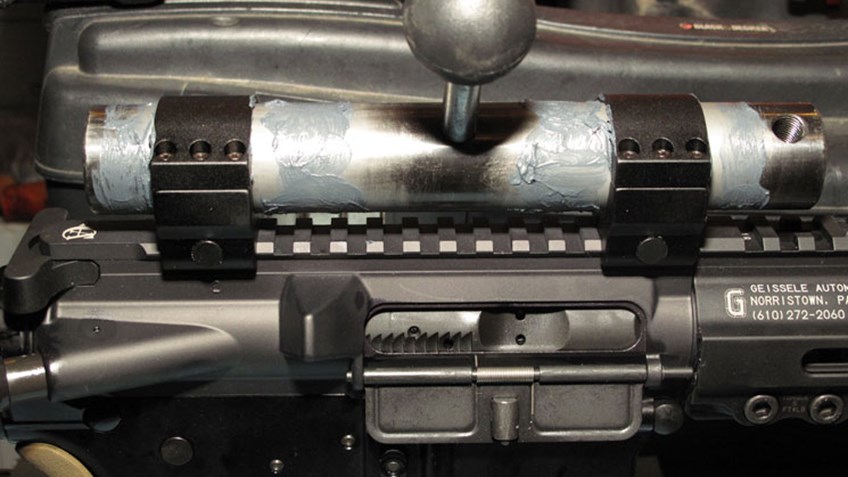
Scope Ring Lapping
Lapping optic mounting rings takes a special tool and patience. I use the Wheeler Engineering Scope Ring Alignment and Lapping Kit (see, REFERENCES AND RESOURCES). If you are not in the habit of mounting your own optics, a qualified gunsmith will usually check ring alignment and lap the rings, if necessary, as part of a scope installation – at a small but worthwhile cost.
I will mention here that with optic mounting rings with “spacing” material, the material itself often serves as a self-aligning medium while providing protection for the barrel of the optic.
There may be a case, even with the best of optic rings, when the optic is out of alignment with the barrel with respect to elevation and/or windage. You may simply “run out of scope” when trying to adjust for elevation and windage where no further adjustment is available, when the objective lens housing is just barely touching the barrel of the rifle and only a few thousands of an inch would prevent the barrel and optic from touching. You could try a higher optic ring, or you could attempt to “shim” the scope.
There are a few optic mounts where insert “shims” can be used inside of the rings to correct an alignment issue. For the most part, these products cause more angst within the person who is attempting to mount the optic than they are worth.
Any “shimming” should be performed at the base with both optic rings and not internal to the rings. Shim kits are available through vendors like Midway and Brownells. However, I feel that any “shimming” should be performed as a last resort and proper selection of optic and properly aligned optic mounting rings usually resolve this type of issue.
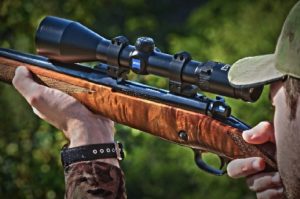 Another thought to consider is “ring spacing” or the distance between each ring in relation to the optic. A common school of thought is that the farther apart your rings the more stable the setup will be, but you loose scope eye relief adjustment by doing that. You have to setup the correct eye relief first then maximize the distance of the ring separation. Since I wear corrective lenses, my aiming eye is typically further from the eyepiece than a person who does not wear corrective lenses; I need a longer eye relief in order to still see the entire field of view. In my case, and with a stock length of 13.75 to 14.2 inches, I find a magnified optic with an eye relief of 4 inches to 6 inches preferable. With a shorter LOP; an eye relief between 3.6 inches to 4 inches is simply wonderful. The more powerful the cartridge being fired, the further from the eyepiece of the optic I prefer to be. Nothing can ruin a shooter’s day than to have an eyepiece slam into the eye brow or a corrective lens.
Another thought to consider is “ring spacing” or the distance between each ring in relation to the optic. A common school of thought is that the farther apart your rings the more stable the setup will be, but you loose scope eye relief adjustment by doing that. You have to setup the correct eye relief first then maximize the distance of the ring separation. Since I wear corrective lenses, my aiming eye is typically further from the eyepiece than a person who does not wear corrective lenses; I need a longer eye relief in order to still see the entire field of view. In my case, and with a stock length of 13.75 to 14.2 inches, I find a magnified optic with an eye relief of 4 inches to 6 inches preferable. With a shorter LOP; an eye relief between 3.6 inches to 4 inches is simply wonderful. The more powerful the cartridge being fired, the further from the eyepiece of the optic I prefer to be. Nothing can ruin a shooter’s day than to have an eyepiece slam into the eye brow or a corrective lens.
I prefer placing the rings between the adjustment points (the turrets) and the leading edge of the bells, and the optic centered above the receiver, if possible, to keep things balanced. On short, tactical optics, say on an AR-based long gun, the placement of the rings may be limited and eye relief measured by the placement of the optic on the rail and adjusting a telescopic stock to obtain a proper eye relief.
You may have a dot optic with no magnification and unlimited eye relief. While most of these types of optic are already loosely packaged with rings, or have an integrated mount, some will use rings that can be swapped with other rings to better fit the firearm. Case in point is the UTG 30mm CQB Red/Green Dot sight. This sight has a Picatinny base with integrated rings. While fine for a Picatinny rail, should I want to run this sight on a Weaver-based rail, I may have to replace the mounting unit to accommodate a Weaver rail system. The unit comes with quad-mounts, but would need a slimmer unit to provide the spacing that I would need for the different rail, and that would mean duplex-mounting rings. The provided QD mounting base with integral rings was exchanged with a set of rings that enabled me to mount the sight on a Mossberg 500 shotgun with a Weaver-style sight base. Of course, the usual mounting considerations (alignment and ring spacing) had to be taken into account like in mounting any other optic. Yes, even red dot sights have to be properly mounted to provide for proper elevation and windage adjustment.
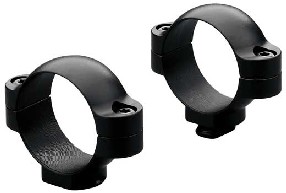
Leupold Ring Example
Also note that ensuring that the placement of the “cap” of the mounting ring plays an important role in ensuring equal tightness of the rings to the optic. The gap on either side of the cap should be as equal as possible. This ensures that the pressure against the optic is balanced.
I had one occasion with a set of optic rings for a 1” optic tube diameter did not tighten the optic when adequately tightened to the proper specification. I could have filed the mating surfaces to create a gap, but since I was lazy, and since I liked the rings, I decided to add a spacer to the inside of the rings. The thickness of common electrical tape is approximately 1mm (approximately 0.40 inch). Common electrical tape is also subject to harden and loosen after time. I had a piece of Talon rubber tape that I had ordered just for experimentation purposes, and according to the manufacturer, the thickness of Talon tape is less than .5mm (approximately 0.20 inch). A layer of Talon rubber tape was sized to the interior of the bottom and top pieces and pressed into place. It was a perfect mating of optic and rings, as it turned out. Not only was the optic secured, it was also cushioned, and there was only a slight gap between the upper and bottom pieces of the rings.
As a note, optic mounting rings may be provided with S.A.E or metric screws. Ensure that you use the proper bit when tightening or loosening these screws to prevent damage to the screws.
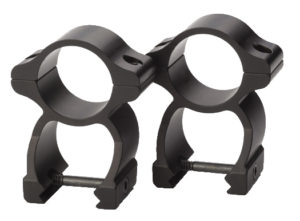
See-Through Style Scope Rings
TO SUMMARIZE:
I would hate for you to, like me, have a drawer dedicated to optic mounts. Thus, the impetus to write this article was to better inform you of different optic mounts so that you can make an informed decision regarding them.
I can’t even recommend optic rings to you, because that is as personal as the rifle and optic that you have. What I will say is that if you have an expensive optic, don’t scrimp on the rings. If you have a relatively inexpensive optic, don’t scrimp on the rings. There are some general guidelines that can be used regarding optic rings, and I share them below:
- Make sure they are tall enough to accommodate the objective lens of your scope, but not so tall that there is too much air space between your scope and the rifle’s receiver.
- Make sure that the rings’ fasteners are all installed with Loc-Tite or some other similar thread locker, since recoil will turn the screws loose.
- Pay attention to torque settings and use a proper tool for tightening the mounting screws. A Wheeler Firearms Accurizing Torque Wrench (a.k.a. Wheeler “Fat Wrench”) is highly recommended.
- Make sure you take the Allen or hex head wrench that the scope rings use with you to the range or in the field in case adjustments need to be made. Remember, any adjustment to the scope rings will require re-zeroing the rifle.
- If you buy quick release rings so that you can share a single scope between two or more rifles, you will have to re-zero anytime the scope is removed.
I hope that you found the article useful.
Now, about that drawer that I have for unused scope lens covers…
REFERENCES AND RESOURCES:
- About Scope Rings and Bases: http://bestriflescopereview.net/scope-rings-and-bases/
- Eye relief: https://en.wikipedia.org/wiki/Eye_relief
- Scope Ring Lapping: https://www.shootingillustrated.com/articles/2013/12/4/scope-ring-lapping/
- Wheeler Engineering Scope Ring Alignment and Lapping Kit: http://www.midwayusa.com/product/2130187492/wheeler-engineering-scope-ring-alignment-and-lapping-kit#
- Wheeler Firearms Accurizing Torque Wrench: https://www.amazon.com/Wheeler-Firearms-Accurizing-Torque-Wrench/dp/B0012AXR4S
- BROWNELLS – SCOPE SHIM KIT: http://www.brownells.com/gunsmith-tools-supplies/sight-scope-installation-tools/scope-shims/scope-shim-kit-prod914.aspx
![]()

